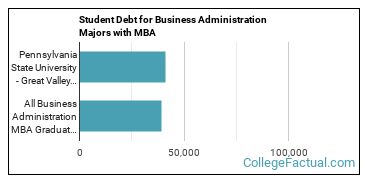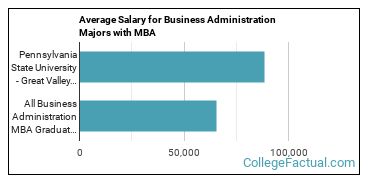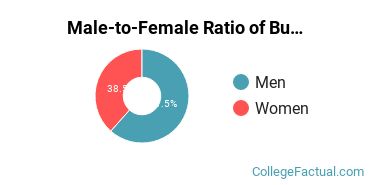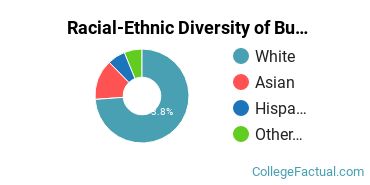Pennsylvania State University - Great Valley MBA in Business Administration & Management
The main focus area for this major is General Business Administration and Management. For more details on this concentration, visit its profile page.
Business Administration & Management is a major offered under the business, management and marketing program of study at Pennsylvania State University - Great Valley. We’ve pulled together some essential information you should know about the master’s degree program in business administration, including how many students graduate each year, the ethnic diversity of these students, whether or not the degree is offered online, and more.
You can jump to any section of this page using the links below:
- Graduate Cost
- Student Debt
- Average Salary
- Online Learning
- Student Diversity
- Related Majors
- Focus Areas
- References
Featured schools near , edit
How Much Does a Master’s in Business Administration from Penn State Great Valley Cost?
Penn State Great Valley Graduate Tuition and Fees
Out-of-state part-time graduates at Penn State Great Valley paid an average of $1,702 per credit hour in 2018-2019. The average for in-state students was $1,044 per credit hour. Information about average full-time graduate student tuition and fees is shown in the table below.
| In State | Out of State | |
|---|---|---|
| Tuition | $25,054 | $40,856 |
| Fees | $760 | $760 |
Penn State Great Valley Business Administration MBA Student Debt
You may also want to consider how much in student loans you’ll need when thinking about the overall cost to attend a school. Students who received their master’s degree at Penn State Great Valley in Business Administration walked away with an average of $41,000 in student debt. That is 5% higher than the national average of $39,110.

How Much Can You Make With a MBA in Business Administration From Penn State Great Valley?
business administration who receive their master’s degree from Penn State Great Valley make an average of $88,600 a year during the early days of their career. That is 35% higher than the national average of $65,781.

Does Penn State Great Valley Offer an Online MBA in Business Administration?
Online degrees for the Penn State Great Valley business administration master’s degree program are not available at this time. To see if the school offers distance learning options in other areas, visit the Penn State Great Valley Online Learning page.
Penn State Great Valley Master’s Student Diversity for Business Administration
Male-to-Female Ratio
Women made up around 38.5% of the business administration students who took home a master’s degree in 2018-2019. This is less than the nationwide number of 47.1%.

Racial-Ethnic Diversity
Around 21.5% of business administration master’s degree recipients at Penn State Great Valley in 2018-2019 were awarded to racial-ethnic minorities*. This is lower than the nationwide number of 32%.

| Race/Ethnicity | Number of Students |
|---|---|
| Asian | 9 |
| Black or African American | 0 |
| Hispanic or Latino | 4 |
| Native American or Alaska Native | 0 |
| Native Hawaiian or Pacific Islander | 0 |
| White | 48 |
| International Students | 0 |
| Other Races/Ethnicities | 4 |
MBA in Business Administration Focus Areas at Penn State Great Valley
Business Administration & Management students may decide to major in one of the following focus areas.
| Focus Area | Annual Graduates |
|---|---|
| General Business Administration and Management | 65 |
Majors Related to a MBA in Business Administration From Penn State Great Valley
You may also be interested in one of these majors related to business administration and management.
| Related Major | Annual Graduates |
|---|---|
| Finance & Financial Management | 15 |
| Management Sciences & Quantitative Methods | 8 |
View All Business Administration & Management Related Majors >
References
*The racial-ethnic minorities count is calculated by taking the total number of students and subtracting white students, international students, and students whose race/ethnicity was unknown. This number is then divided by the total number of students at the school to obtain the racial-ethnic minorities percentage.
More about our data sources and methodologies.

